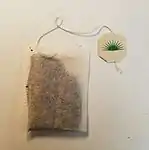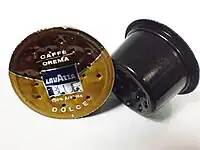

A single-serve coffee container is a container filled with coffee grounds, used in coffee brewing to prepare only enough coffee for a single portion. They come in various formats and materials, often either as hard and soft pods or pads made of filter paper, or hard aluminium and plastic capsules.
Single-serve coffee containers can both reduce the time needed to brew coffee and simplify the brewing process by eliminating the need to measure out portions, flavorings, and additives from large bulk containers. They can also help to keep the unused product fresher by individually packaging portions separately without exposing the entire supply batch to air and light. Paper coffee pods can be functionally identical to plastic and metal coffee capsules, if the paper pods are individually sealed in separate bags. At the same time, the disposable single-use products add to the global waste production.
History
In 1958, the Flemish Rombouts coffee company launched its pre-filled One Cup Coffee Filter for the Brussels World Exhibition. Unlike newer capsules and pods, this system consists of a single-use drip coffee filter placed over the cup. In 1964, the company began marketing the concept, gaining success in the horeca and retail sectors. The company was founded in Antwerp in 1896, and in 1966 was appointed a "Certified Royal Warrant Holder of Belgium".[1][2]
Variations
Several different systems exist:
- Coffee pods or pads are pre-packaged ground coffee beans in their own filter.
- A coffee capsule differs from a coffee pod in that the coffee is packed in a plastic or aluminum package instead of a paper filter, and it is usually designed for use with a single brand or system and is therefore not interchangeable with other systems. A patent on the Nespresso system expired at the end of 2012, and there are now rival capsules available for the Nespresso system.[3]
- A variation, coffee bags, were developed to provide the convenience of instant coffee but maintain the flavor of brewed coffee. Modeled after tea bags, they consist of a gauze bag containing a mixture of instant coffee and finely ground roast coffee, which is to be steeped in hot water for approximately three minutes.[4]
- Coffee (filter) disks or ground coffee filter rings are a ring-type variant of coffee bags made of coffee filter paper containing ground roast coffee for use in coffee percolators, which otherwise use permanent filters made out of metal or porcelain. One of the first companies to offer them was General Foods Corp. with their "Max-Pax" filter rings.
 Photo of coffee bag manufactured by Folgers
Photo of coffee bag manufactured by Folgers A paper coffee bag by an unknown manufacturer - E.S.E. (Easy Serving Espresso Pod)
A paper coffee bag by an unknown manufacturer - E.S.E. (Easy Serving Espresso Pod) A Senseo ESE coffee pod, upside down
A Senseo ESE coffee pod, upside down Used Lavazza BLUE coffee capsules, showing the puncture holes
Used Lavazza BLUE coffee capsules, showing the puncture holes
Comparison of systems
The plastic and metal coffee capsules typically are used in a non-removable receptacle on the brewing device. The capsules have an outer ring or rim that stays dry during use, allowing for removal and disposal after use without getting the user's hands wet or sticky. Handling of a used moist coffee pod is not necessary if the brewing device has a removable filter tray. This tray is removed after brewing and inverted to eject the used coffee pod.
Coffee pods, bags, and capsules can be sized for individual or multi-serving portions. In food service businesses, pods and capsules used with automatic brewing can help to provide consistency of product strength and flavor for customers.
Paper coffee pods such as those used in Easy Serving Espresso Pod or Senseo machines have the benefit of being a fully biodegradable product that can decompose naturally, while plastic and metal capsules such as those used in Keurig or Nespresso machines either are not recyclable, or require additional processing to separate the plastic/metal container from the organic waste products.
Many capsule machines specifically warn the user to not disassemble the machine or put their fingers inside the capsule receptacle, as the devices commonly use sharp razor-edge tubes or prongs for piercing the coffee capsule during use.
Different single-cup systems are not interchangeable; some systems force machine owners to buy capsules from a single company (usually the patent owner), locking the machine owner into a single source of coffee. Coffee pods are made by a variety of manufacturers and are interchangeable between brand of pod and model of pod brewer most of the time.
| System | Owned by | Year invented | Machine manufacturers | Capsule / pod manufacturers | Markets | Type | Notes |
|---|---|---|---|---|---|---|---|
| Espresso Point MAXI | Lavazza | 1992 | The ECL (Espresso e Cappuccino Lavazza) branded as 1x | Lavazza | Worldwide | Capsule | The ECL used a bi-dose capsule system and had a double dispensing head that could brew two coffees at the same time. |
| Espresso Point | Lavazza | 1983 | Uno Per branded as 1x | Lavazza | Worldwide | Capsule | The single-dose capsule machine by Uno Per (Gattinara), acquired by Lavazza in 1989 |
| Espressotoria | Vittoria Coffee | ? | ? | Own brand | Worldwide | Capsule | Australian coffee brand that produces its own pods for its Espressotoria machines[5] as well as Nespresso-compatible pods. |
| A Modo Mio | Lavazza | 2007 | Saeco (Philips) branded as Lavazza/Gaggia, Electrolux | Lavazza | Worldwide | Capsule | Lavazza vertical |
| BLUE | Lavazza | 2003 | ? | Lavazza | Worldwide | Capsule | BLUE stands for "Best Lavazza Ultimate Espresso” - mostly used in business and vending machines |
| Bialetti Diva | Bialetti | 2013 | Bialetti | Caff dÕItalia | Worldwide | Capsule | — |
| Bodecker Brewer | Bodecker Brewed | 2005 | TBD | Bodecker Brewed | Canada | Capsule | — |
| Caffitaly (Caffita) | Caffita System SPA | 2004 | Various inc. Princess of Netherlands, Tchibo, Gaggia until recently | Various, inc. Dualit, Gaggia, Ecaffe, CBTL, Gloria Jeans, MAP, Woolworths | Central Europe, Northern Europe, Brazil, Australia | Capsule | Physically compatible with K-Fee machines/pods |
| Delta Q | Delta Cafés | 2007 | Flama, branded Delta Cafés, Brasilia S.p.A., Casa Bugatti | Delta Cafés, Tetley | Canada, Portugal, Spain, Luxembourg, Brazil, Angola | Capsule | — |
| Dolce Gusto | Nestle | 2008 | Krups, Delonghi, branded Nescafe. | Nescafe (Nestle) | Worldwide | Capsule | Nestle vertical. Also brews cold beverages. Limited Edition machine designs also available. Rewards program.Capsule recycling programs exist in some countries. |
| Easy Serving Espresso Pod (ESE) | Italian ESE Consortium for Development | 1998 (standard) and previous | Various including Delonghi, Dualit, FrancisFrancis, Handpresso, Kitchenaid, Krups and Saeco | Various | Worldwide | Pod | Open, generic standard not tied to particular vendors, pods fit most traditional espresso machines. Not all pods are 44 mm (the standard diameter). |
| Flavia Beverage Systems | Mars, Inc. | 1984 | Flavia (Mars) | Flavia (Mars) | United States, United Kingdom | Capsule | The "fresh pack" (the capsule) is the brewing vessel, so that the drink is not tainted by previous user. Controlled by Mars. |
| Folgers | Folgers | 1953 | None needed | The J.M. Smucker Co. | United States | Bag | Folgers coffee singles,[4] instant coffee |
| iperEspresso | Illy | 2007 | FrancisFrancis (Illy), Gaggia[6] (Saeco), Cuisinart[7] | Illy | Worldwide | Capsule | Recyclable[8] |
| K-Cup (Keurig) | Green Mountain Coffee Roasters | 1992 | Many: Keurig, Breville, Cuisinart, Insignia, etc. | Many, including Green Mountain | United States, Canada | Capsule | My K-Cup available as a reusable filter for using any filter coffee prior to the Keurig 2.0 system. |
| Compostable K-Cup | OneCoffee | 2017 | Many: Keurig, Cuisinart, BUNN etc. | Many, including OneCoffee and Club Coffee | United States, Canada | Capsule | A soft-bottomed pod compatible with any Keurig machine, including 2.0. |
| K-Fee | KRÜGER Group | 2010 | Aldi Expressi, K Systems GMBH Preferenza | K-Fee, Paulig Cupsolo, Starbucks Verismo | United States, Europe, Australia | Capsule | Physically compatible with CaffeItaly machines/pods |
| Nespresso (Original Line) |
Nestle | 1976 | Eugster/Frismag branded as Krups, Magimix, Siemens; Delonghi make Latissima model | Nespresso | Worldwide | Capsule (Pod in bars[9]) | In 1976, Eric Favre, an employee of Nestlé, invented, patented and introduced the Nespresso system[10][11] Nestle-controlled system |
| Nespresso VertuoLine | Nestle | 2014 | ? | Nespresso | United States, Canada, France, United Kingdom, Australia, Japan | Capsule | Nestle-controlled system |
| Coffee Pods | None | 2001 (Senseo patent) | Bunn, Philips, Melitta, Grindmaster, Cuisinart, CafeXpress, etc. | Douwe Egberts, Café Liégeois, Reunion Island, Wolfgang Puck, Melitta, Fratello Coffee Roasters, etc. | Worldwide | Pod | Not owned by a specific corporation. Many more manufacturers of pods and brewers exist. Also biodegradable. |
| T-Discs (Tassimo) | JDE Peet's | 2004 | Bosch branded as TASSIMO | JDE Peet's and Kraft Heinz (in Canada and United States) | United States, Canada, Mexico, Europe | Capsule | — |
Environmental impact
Environmental activists have said that single-use coffee pods are harmful, as they are often composed of a mix of plastic, aluminium, and organic material (the used coffee) which makes them difficult to recycle. In early 2016 the German city of Hamburg banned coffee capsules from state-run buildings on environmental grounds.[12][13] There are some capsules that are plant-based and that can be compostable as bio-waste.[14]
See also
References
- ↑ "Rombouts Coffee - Blog - History". www.rombouts.com. Archived from the original on 2022-09-30. Retrieved 2023-03-19.
- ↑ "All About Royal Families". Archived from the original on 2023-03-19. Retrieved 2023-03-19.
- ↑ Nespresso compatible pods for coffee, Best Nespresso Machine, retrieved 2019-12-13
- 1 2 "Classic Roast Singles – Folgers Coffee". Retrieved 2017-04-14.
- ↑ FAQ, Vittoria Coffee
- ↑ "Gaggia for illy plus single serve". gaggia-usa.com.
- ↑ "Buona Tazza Collection Side-by-side comparison". Cuisinart.com. Retrieved 2015-05-06.
- ↑ "Introducing the iperEspresso Capsule Recycle Program". Illy.com. Retrieved 2014-07-05.
- ↑ Commercial Coffee Capsule Range (Nespresso Pro Spain)
- ↑ Societé (in French), CH: Monodor, archived from the original on 2008-05-03
- ↑ History, Monodor
- ↑ "Is there a serious problem with coffee capsules?". 2016-02-19. Retrieved 2017-04-14 – via www.bbc.co.uk.
- ↑ "Is Tassimo being phased out or going out of business?". 2017-06-21. Retrieved 2017-06-21.
- ↑ "Plant based capsules challenge Nespresso". 2016-02-24. Retrieved 2017-11-26.